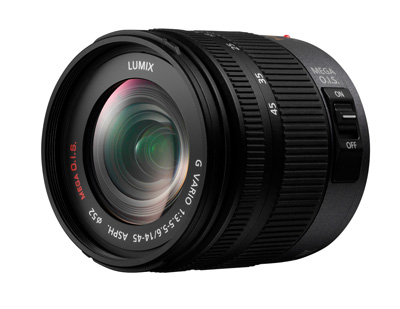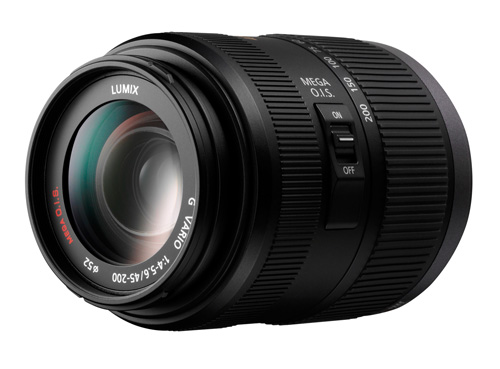Panasonic G1: Smallest and Lightest Interchangeable Lens Digital Camera
by Wesley Fink on September 15, 2008 1:00 PM EST- Posted in
- Digital Camera
Micro Four Thirds Lenses Press Release
PANASONIC INTRODUCES WORLD'S FIRST INTERCHANGEABLE LENSES FOR MICRO FOUR THIRDS SYSTEM DIGITAL CAMERAS
Two New Lenses Compatible with LUMIX G1, the World's Smallest & Lightest Interchangeable Lens Digital Camera, Part of the Micro Four Thirds System
SECAUCUS, NJ - Panasonic announces the world's first interchangeable lenses designed for the new Micro Four Thirds System. The LUMIX G VARIO 14-45mm/F3.5-5.6 ASPH/MEGA O.I.S will be the standard kit lens with the LUMIX DMC-G1, the world's first Micro Four Thirds System digital camera, which also debuted today. In addition, the LUMIX G VARIO 45-200mm/F4.0-5.6/MEGA O.I.S. telephoto lens, also designed for the Micro Four Thirds format, offers an enhanced zoom range for use with the DMC-G1 and other cameras based on the new standard.

Panasonic's two new Micro Four Thirds System lenses produce professional-level images, typical of digital single-reflex lens (DSLR) cameras, while greatly reducing the size. For instance, the LUMIX G VARIO 14-45mm/F3.5-5.6 ASPH./MEGA O.I.S lens is nearly half the size and weight of traditional DSLR lenses with comparable focal lengths. Both lenses feature Panasonic's Mega O.I.S. (optical image stabilizer), which helps reduce blur caused by hand movement when snapping photos, and are compatible with Panasonic's Contrast AF (Auto Focus) system found in the LUMIX DMC-G1. Contrast AF in the G1 allows the user to choose from a wide-range of AF modes, including: multiple-area AF with up to 23 focus areas; 1-area AF with a selectable focus area; Face Detection; and AF Tracking. The lenses also feature a durable metal mount and multi-coated lens to reduce ghosts and flares on images. In addition, seven aperture blades create a rounded shape that produces smoothness when shooting out-of-focus areas, helping to deliver top optical performance.

"The introduction of the Micro Four Thirds System is a huge advancement for digital photographers as the reduction in size and weight of these lenses will really change the market and make this format more approachable," said David Briganti, National Marketing Manager, Imaging, Panasonic Consumer Electronics Company. "Average consumers interested in purchasing an advanced camera were previously deterred by the bulkiness and inconvenience of DSLRs, so these new lenses provide the same level of quality that consumers demand, but in a package much more suitable for active lifestyles."
The LUMIX G VARIO 14-45mm/F3.5-5.6ASPH./MEGA O.I.S. will be part of the kit with the LUMIX DMC-G1 body and will be available in mid-November. The LUMIX G VARIO 45-200mm/F4.0-5.6/MEGA O.I.S. will also be available in November. Pricing for the both lenses will be announced in early October.










20 Comments
View All Comments
computerfarmer - Thursday, November 27, 2008 - link
There is a detailed review at the following site.http://www.digitalcamerainfo.com/content/Panasonic...">http://www.digitalcamerainfo.com/conten...ix-G1-Di...
It is compared with Nikon D90/D60, Olympus 520, Canon Rebel XSi(450).
I would like to see this camera with the 2 lens kit.
aeternitas - Monday, September 15, 2008 - link
http://www.dpreview.com/previews/panasonicG1">http://www.dpreview.com/previews/panasonicG1whatthehey - Monday, September 15, 2008 - link
It's amazing that no one else can manage to get pre-release digital cameras (particularly DSLR) other than dpreview. I mean, it's almost like they're owned by some company that has early access to hardware, and they use that to gain an advantage. Oh, wait....http://www.dpreview.com/news/0705/07051402amazonac...">http://www.dpreview.com/news/0705/07051402amazonac...
Now the only question is whether their integrity is compromised by the ownership. At the very least, they have an effective monopoly on digital camera previews, which is rather disconcerting. What I don't understand is why the camera companies don't want other sites to get in on the action. It's almost like they're stuck in a pre-digital world trying to figure out how to cope with the internet.
Marketing: "Hey, we should send out a bunch of camera samples to web sites. They'll provide reviews, which are essentially free advertising! All it costs us is shipping plus the hardware, which is a damn sight cheaper than any other form of advertising (and more effective to boot)."
Marketing VP: "HELLS NO! We can't let anyone have early access to our product! It will kill our profits! THINK OF THE CHILDREN!"
Wesley Fink - Monday, September 15, 2008 - link
Thanks for your comment. You certainly understand our frustration in trying to get camera info and samples to review. Frankly we have asked every manufacturer repeatedly, but we have yet to review even ONE camera provided by a manufacturer. We have been buying the cameras wherever we can as fast aswe can and then reselling them after review.The manufacturers keep saying nice things over the last two years, but none of them has ever delivered anything for review. It is still pulling teeth just to get on and remain on, press release lists. This is certainly totally unlike our presence in the computer market and it can be quite frustrating.
We do think our perspective on electronics is quite different from other imaging review sites and we hoped that some manufacturers would see that as a new opportunity for a fair and frank review. Perhaps over time that will eventually happen.
aeternitas - Monday, September 15, 2008 - link
I think it would help manufacturers have a greater trust in the sites review abilities if there was some sort of standard you guys came up with when reviewing them. Resolution cards, constant scenes in consistent lighting that can be taken to show differences in different ISO settings to build a database against other cameras.It has not seemed yet like the reviews have any sort of constants to compare other reviewed cameras here against. Color, sharpness, noise true resolution ect ect. One can put the coolest name they want on their image processor but the outcome is what matters, and it’s too hard to compare totally different scenes with the help of impractical numbers.
Controlled consistant scenes + onmouseover images for the review itself = your friend.
slashbinslashbash - Monday, September 15, 2008 - link
The benefit of SLR's in the film world was obvious. The importance of the "Single Lens" in the "Single Lens Reflex" equation was obvious. What you see in the viewfinder = what will be imaged on the film. In the digital world, with live view screens showing the actual sensor image even more precisely than most optical DSLR viewfinders (only the most expensive have 100% viewfinders), there is no longer any need for the "reflex" part of the "SLR" construction. That whole flipping-mirror thing was just a workaround, a hack, a kludge. Panasonic is the first to realize this, and create a digital camera with interchangeable lenses that opens up the full range of possiblities for digital imaging. The mirror box meant that there would always be a gap of some 20mm (more or less) from the sensor to the back of the lens; thus making lenses with focal lengths of less than approx. 20mm extremely difficult to engineer. Now that the mirror box is gone, the lens can get much closer to the sensor, and hugely wide angles should be attainable, even on a relatively small sensor like the 4/3rds.strikeback03 - Tuesday, September 16, 2008 - link
I don't like any previous EVF I have seen, but I'll reserve judgement on this until I have actually looked at one. The DPR preview said it got grainy when gained up a lot at night, have to see how bad that really is compared to an optical viewfinder. Same with the autofocus - they say it is fast, but I want to see how fast and accurate it is.SLRs typically have a registration distance of around 40mm, this halves that to 20mm. So anything wider than 20mm (which isn't wide on 4/3) will be retrofocal, and to beat the current widest rectilinear lens (Sigma 12-24 on film/FF digital) they will need a lens wider than 6mm.
For whoever said they want a more rangefinder shape, I'm sure that could be done, but their product research probably said the more traditional shape would sell better. Sales of the Olympus E300/E330 were not helped by being a somewhat non-traditional layout.
Maxington - Tuesday, September 16, 2008 - link
" In the digital world, with live view screens showing the actual sensor image even more precisely than most optical DSLR viewfinders"Except electronic viewfinders bring their own parcel of problems.
I just wish they'd stop with the half-assed semi-DSLR body shape and size, and go straight for a very compact, rectangular rangefinder size mobody.
I don't want a slightly smaller DSLR, or I would've bought the Olympus E420. I want a digital rangefinder that doesn't suck and cost the earth like the Leica M8 does.
AnnihilatorX - Tuesday, September 16, 2008 - link
Read the review by dpreview.comI haven't see a single bad thing about live view so far.
Maxington - Wednesday, September 17, 2008 - link
"Read the review by dpreview.comI haven't see a single bad thing about live view so far. "
You try panning fast, or pointing into into bright lights, or darkness.
I've read the Preview of the G1. EVF has advantages, but it also had disadvantages.
I'd kinda like a hybrid OVF/EVF if I could, sort of a heads-up display where it can overlay histograms and other information, but you can disable it if need be. Of course, that still requires a mirror assembly, so its back to DSLR territory anyhow.